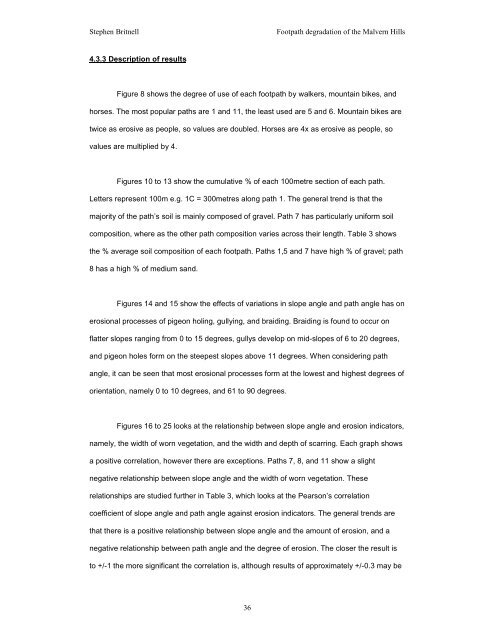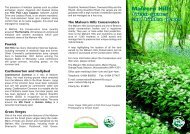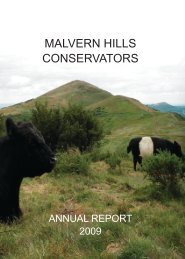Footpath degradation of the Malvern Hills - Malvern Hills Conservators
Footpath degradation of the Malvern Hills - Malvern Hills Conservators
Footpath degradation of the Malvern Hills - Malvern Hills Conservators
Create successful ePaper yourself
Turn your PDF publications into a flip-book with our unique Google optimized e-Paper software.
Stephen Britnell<br />
<strong>Footpath</strong> <strong>degradation</strong> <strong>of</strong> <strong>the</strong> <strong>Malvern</strong> <strong>Hills</strong><br />
4.3.3 Description <strong>of</strong> results<br />
Figure 8 shows <strong>the</strong> degree <strong>of</strong> use <strong>of</strong> each footpath by walkers, mountain bikes, and<br />
horses. The most popular paths are 1 and 11, <strong>the</strong> least used are 5 and 6. Mountain bikes are<br />
twice as erosive as people, so values are doubled. Horses are 4x as erosive as people, so<br />
values are multiplied by 4.<br />
Figures 10 to 13 show <strong>the</strong> cumulative % <strong>of</strong> each 100metre section <strong>of</strong> each path.<br />
Letters represent 100m e.g. 1C = 300metres along path 1. The general trend is that <strong>the</strong><br />
majority <strong>of</strong> <strong>the</strong> path’s soil is mainly composed <strong>of</strong> gravel. Path 7 has particularly uniform soil<br />
composition, where as <strong>the</strong> o<strong>the</strong>r path composition varies across <strong>the</strong>ir length. Table 3 shows<br />
<strong>the</strong> % average soil composition <strong>of</strong> each footpath. Paths 1,5 and 7 have high % <strong>of</strong> gravel; path<br />
8 has a high % <strong>of</strong> medium sand.<br />
Figures 14 and 15 show <strong>the</strong> effects <strong>of</strong> variations in slope angle and path angle has on<br />
erosional processes <strong>of</strong> pigeon holing, gullying, and braiding. Braiding is found to occur on<br />
flatter slopes ranging from 0 to 15 degrees, gullys develop on mid-slopes <strong>of</strong> 6 to 20 degrees,<br />
and pigeon holes form on <strong>the</strong> steepest slopes above 11 degrees. When considering path<br />
angle, it can be seen that most erosional processes form at <strong>the</strong> lowest and highest degrees <strong>of</strong><br />
orientation, namely 0 to 10 degrees, and 61 to 90 degrees.<br />
Figures 16 to 25 looks at <strong>the</strong> relationship between slope angle and erosion indicators,<br />
namely, <strong>the</strong> width <strong>of</strong> worn vegetation, and <strong>the</strong> width and depth <strong>of</strong> scarring. Each graph shows<br />
a positive correlation, however <strong>the</strong>re are exceptions. Paths 7, 8, and 11 show a slight<br />
negative relationship between slope angle and <strong>the</strong> width <strong>of</strong> worn vegetation. These<br />
relationships are studied fur<strong>the</strong>r in Table 3, which looks at <strong>the</strong> Pearson’s correlation<br />
coefficient <strong>of</strong> slope angle and path angle against erosion indicators. The general trends are<br />
that <strong>the</strong>re is a positive relationship between slope angle and <strong>the</strong> amount <strong>of</strong> erosion, and a<br />
negative relationship between path angle and <strong>the</strong> degree <strong>of</strong> erosion. The closer <strong>the</strong> result is<br />
to +/-1 <strong>the</strong> more significant <strong>the</strong> correlation is, although results <strong>of</strong> approximately +/-0.3 may be<br />
36





